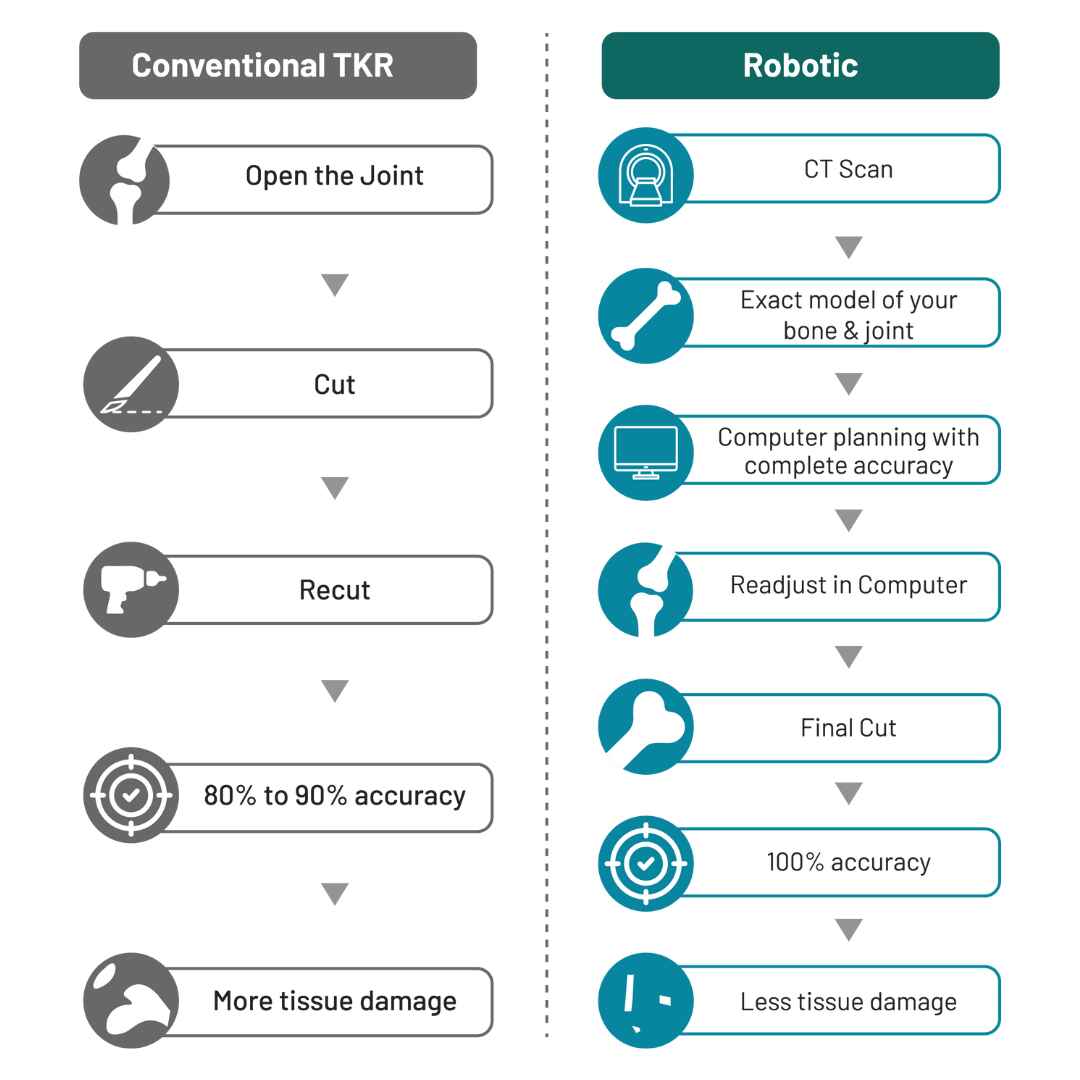Conventional TKR vs. Robotic Surgery using Cuvis Joint: Unraveling the Advancements in Precision Knee Replacement
Introduction:Total knee replacement (TKR) has long been a reliable solution for individuals suffering from debilitating knee conditions. However, recent advancements in medical technology have introduced a new approach to TKR: robotic surgery using Cuvis joint. In this blog, we will explore the differences between conventional TKR and robotic surgery, shedding light on the revolutionary precision and customization offered by the Cuvis joint technology.
Conventional Total Knee Replacement: Conventional TKR is a well-established surgical procedure that involves replacing the damaged knee joint surfaces with artificial implants. The surgeon carefully measures and prepares the bone surfaces before attaching the implants, aiming to restore joint functionality. While conventional TKR has been successful in providing pain relief and improved mobility, it does have its limitations.
Robotic Surgery using Cuvis Joint:Robotic surgery has emerged as a groundbreaking technique in the field of orthopedics, revolutionizing the precision and accuracy of TKR. Cuvis joint, a state-of-the-art robotic platform, enhances the surgical process by combining advanced imaging and 3D modeling technology. The surgeon utilizes a robotic arm to execute the procedure with unparalleled precision, guided by the personalized surgical plan created using Cuvis joint.
Differences between Conventional TKR and Robotic Surgery using Cuvis Joint:
Pre-operative Planning: In conventional TKR, surgeons rely on manual measurements and pre-operative imaging to plan the surgery. However, with robotic surgery, Cuvis joint technology generates a detailed surgical plan based on advanced imaging and 3D modeling, resulting in a more precise and individualized approach.
Surgical Execution:Conventional TKR relies on the surgeon's manual technique to perform the procedure. In contrast, robotic surgery employs a surgeon-guided robotic arm, enabling precise bone cuts and accurate implant placement. The robotic arm's controlled movements reduce human variability, enhancing surgical outcomes.
Accuracy and Alignment:Achieving optimal alignment is crucial for the longevity and functionality of the implanted joint. Conventional TKR may have inherent human errors and variability, leading to potential alignment issues. Robotic surgery with Cuvis joint ensures enhanced accuracy and alignment, minimizing the risk of implant misplacement and maximizing joint functionality.
Customization:Conventional TKR is limited in terms of customization, as it relies on the surgeon's experience and judgment. In robotic surgery, Cuvis joint technology allows for personalized surgical planning based on the patient's unique anatomy. This customization ensures an optimized surgical outcome and a better fit for the patient's knee joint.
Post-operative Recovery:While both conventional TKR and robotic surgery involve post-operative rehabilitation, robotic surgery may offer potential benefits in terms of faster recovery and improved outcomes. The precise implant placement and alignment achieved through robotic surgery can contribute to reduced pain, improved range of motion, and quicker return to daily activities.
Considerations and Patient Selection:When deciding between conventional TKR and robotic surgery using Cuvis joint, several factors should be considered. Patient suitability, including factors like age, overall health, and severity of the knee condition, should be assessed. It is essential for patients to consult with an experienced orthopedic surgeon who can guide them in choosing the most appropriate approach.
Patient Experiences and Outcomes:Real-life patient testimonials showcase the transformative impact of robotic surgery using Cuvis joint. Patients often report reduced pain, improved joint functionality, and enhanced quality of life following the procedure. Success rates and clinical outcomes further validate the effectiveness of this advanced approach.
Cost and Accessibility:Cost considerations and insurance coverage may play a role in the selection of TKR approaches. While robotic surgery using Cuvis joint may have higher upfront costs, it is essential to evaluate the long-term benefits and potential reduction in complications. The availability of robotic surgery may vary depending on the healthcare facility and region.
Future of Robotic Knee Replacement Surgery:The future of robotic knee replacement surgery holds promising advancements. Ongoing research focuses on refining the Cuvis joint technology, incorporating artificial intelligence and machine learning for further enhancements. These advancements aim to improve surgical outcomes, patient experiences, and expand accessibility to this innovative approach.
Conclusion:Conventional TKR and robotic surgery using Cuvis joint represent two distinct approaches to total knee replacement. While conventional TKR has been a reliable option for years, the emergence of robotic surgery has brought unprecedented precision and customization to the field. With Cuvis joint technology, patients can experience improved alignment, enhanced functionality, and potentially faster recovery. By consulting with a qualified orthopedic surgeon, patients can make an informed decision regarding the best approach for their specific needs, ensuring optimal outcomes and a renewed quality of life.



